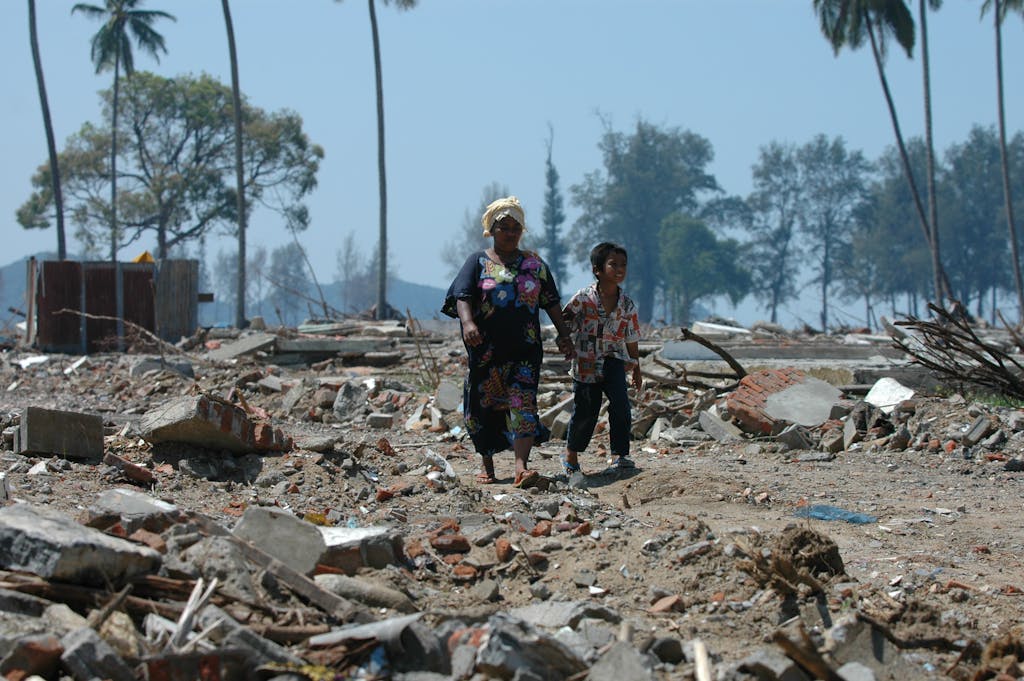Tsunamis, often referred to as “harbor waves” in Japanese, are one of nature’s most devastating phenomena. Triggered by undersea earthquakes, volcanic eruptions, or landslides, tsunamis unleash powerful waves capable of causing widespread destruction and loss of life. This article explores the science behind tsunamis, highlights historical events, and provides a comprehensive guide on safety measures, early warning systems, and survival strategies.
What Causes a Tsunami?
Tsunamis originate from large-scale disturbances in the ocean. These disturbances displace enormous amounts of water, generating waves that can travel at speeds exceeding 800 kilometers per hour (500 mph) in the deep ocean. As the waves approach shallow coastal areas, their speed decreases, but their height increases dramatically, leading to devastating impacts.
Key Triggers of Tsunamis:
- Undersea Earthquakes:
- Responsible for over 80% of tsunamis worldwide.
- Example: The 2004 Indian Ocean tsunami, caused by a 9.1 magnitude earthquake, claimed over 230,000 lives.
- Volcanic Eruptions:
- Volcanic explosions or collapses can displace water, as seen in the 1883 Krakatoa eruption, which generated waves over 40 meters (131 feet) high.
- Landslides:
- Submarine landslides or coastal collapses displace water, such as the 1958 Lituya Bay tsunami in Alaska, which produced a record-breaking wave height of 524 meters (1,720 feet).
Tsunami Wave Characteristics
Wave Speed:
- In the open ocean, tsunamis can travel as fast as a jet plane (500–800 km/h), but they slow to 30–50 km/h near coastlines.
Wave Height:
- Open ocean waves are typically less than 1 meter (3 feet) tall.
- Nearshore waves can exceed 30 meters (98 feet), causing catastrophic flooding.
Wave Duration:
- Tsunami waves come in series, often referred to as “wave trains,” with intervals ranging from 5 to 90 minutes. The first wave is not always the largest or most destructive.
Historical Tsunamis: Lessons Learned
1. The 2004 Indian Ocean Tsunami
- Impact: Affected 14 countries, including Indonesia, Thailand, and Sri Lanka.
- Casualties: Over 230,000 deaths.
- Lesson: Highlighted the need for a robust global early warning system.
2. The 2011 Tōhoku Tsunami (Japan)
- Impact: Triggered by a 9.0 magnitude earthquake, waves reached heights of 40.5 meters (133 feet).
- Casualties: Over 15,000 deaths and severe damage to the Fukushima Daiichi nuclear plant.
- Lesson: Reinforced the importance of tsunami-resistant infrastructure and evacuation planning.

Safety Measures and Survival Strategies
1. Early Warning Systems
- Modern tsunami warning systems rely on seismic data and ocean buoys to detect underwater disturbances.
- Example: The Pacific Tsunami Warning Center (PTWC) provides real-time alerts to coastal nations.
2. Evacuation Plans
- Coastal communities must have well-defined evacuation routes leading to high ground.
- Key Action: Move at least 30 meters (100 feet) above sea level or 2 kilometers (1.2 miles) inland.
3. Recognizing Natural Warning Signs
- Unusual ocean behavior, such as rapid water recession or a sudden rise, may indicate an impending tsunami.
- Strong or prolonged earthquakes near the coast are immediate red flags.
1200 tsunamis have occurred since 3000 years ago, and 70% of the waves are considered to be within specific areas, Since 2008, UNESCO has been documenting and counting the locations and places of tsunamis around the world.
4. Building Tsunami-Resistant Infrastructure
- Elevated structures and reinforced buildings can mitigate damage.
- Example: Japan’s seawalls and tsunami evacuation towers.
5. Education and Community Preparedness
- Regular drills and public awareness campaigns ensure communities know how to respond effectively.
Steps to Survive a Tsunami
- React Quickly:
- If you feel an earthquake near the coast, evacuate immediately without waiting for official alerts.
- Head to High Ground:
- Seek elevated areas or sturdy structures. Avoid valleys or river paths that amplify wave impacts.
- Stay Informed:
- Use radios or mobile alerts to monitor updates from official sources.
- Avoid Returning Prematurely:
- Wait for official clearance, as multiple waves can occur over several hours.
Post-Tsunami Rescue and Recovery
1. Search and Rescue Operations
- Teams prioritize locating survivors trapped in debris or stranded in flooded areas.
- Technologies like drones and thermal imaging enhance rescue efficiency.
2. Humanitarian Aid
- Immediate focus on providing clean water, food, and medical care to affected populations.
- Example: After the 2004 tsunami, international aid reached over $14 billion.
3. Long-Term Recovery
- Reconstruction of homes and infrastructure incorporates tsunami-resistant designs.
- Mental health support addresses trauma among survivors.
The expected evacuation period in the event of a tsunami will be 20 minutes from the time the warning is issued. This period must be thought through and evacuation must be carried out intelligently.
Conclusion
Tsunamis are among the most destructive natural disasters, but with proper understanding, preparation, and response, their impact can be significantly mitigated. Architects, urban planners, and policymakers play critical roles in designing resilient coastal communities and ensuring the safety of vulnerable populations. By learning from past events and leveraging modern technologies, we can build a safer future for coastal regions worldwide.
For insights into innovative architectural solutions, visit Who We Are or explore the professional team behind groundbreaking designs at INJ Architects Team.
Sources:
- National Oceanic and Atmospheric Administration (NOAA), “Tsunami Science and Preparedness,” 2022.
- United Nations Office for Disaster Risk Reduction (UNDRR), “Global Tsunami Risk Assessment,” 2021.
